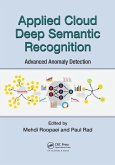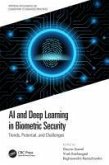Bhavani Thuraisingham, Murat Kantarcioglu, Latifur Khan
Secure Data Science
Integrating Cyber Security and Data Science
Bhavani Thuraisingham, Murat Kantarcioglu, Latifur Khan
Secure Data Science
Integrating Cyber Security and Data Science
- Broschiertes Buch
- Merkliste
- Auf die Merkliste
- Bewerten Bewerten
- Teilen
- Produkt teilen
- Produkterinnerung
- Produkterinnerung
This book is a useful resource for researchers, software developers, educators and managers who want to understand both the high level concepts as well as the technical details on the design and implementation of secure data science-based systems. It can also be used as a reference book for a graduate course in Secure Data Science.
Andere Kunden interessierten sich auch für
![Data Science and Big Data Analytics in Smart Environments Data Science and Big Data Analytics in Smart Environments]() Data Science and Big Data Analytics in Smart Environments80,99 €
Data Science and Big Data Analytics in Smart Environments80,99 €![Data Analytics Applied to the Mining Industry Data Analytics Applied to the Mining Industry]() Ali SoofastaeiData Analytics Applied to the Mining Industry92,99 €
Ali SoofastaeiData Analytics Applied to the Mining Industry92,99 €![Applied Cloud Deep Semantic Recognition Applied Cloud Deep Semantic Recognition]() Applied Cloud Deep Semantic Recognition61,99 €
Applied Cloud Deep Semantic Recognition61,99 €![Reinforcement Learning for Cyber-Physical Systems Reinforcement Learning for Cyber-Physical Systems]() Chong LiReinforcement Learning for Cyber-Physical Systems65,99 €
Chong LiReinforcement Learning for Cyber-Physical Systems65,99 €![AI and Deep Learning in Biometric Security AI and Deep Learning in Biometric Security]() AI and Deep Learning in Biometric Security78,99 €
AI and Deep Learning in Biometric Security78,99 €![Cyber Arms Cyber Arms]() Stanislav AbaimovCyber Arms107,99 €
Stanislav AbaimovCyber Arms107,99 €![Privacy Vulnerabilities and Data Security Challenges in the Iot Privacy Vulnerabilities and Data Security Challenges in the Iot]() Privacy Vulnerabilities and Data Security Challenges in the Iot78,99 €
Privacy Vulnerabilities and Data Security Challenges in the Iot78,99 €-
-
-
This book is a useful resource for researchers, software developers, educators and managers who want to understand both the high level concepts as well as the technical details on the design and implementation of secure data science-based systems. It can also be used as a reference book for a graduate course in Secure Data Science.
Hinweis: Dieser Artikel kann nur an eine deutsche Lieferadresse ausgeliefert werden.
Hinweis: Dieser Artikel kann nur an eine deutsche Lieferadresse ausgeliefert werden.
Produktdetails
- Produktdetails
- Verlag: Taylor & Francis Ltd (Sales)
- Seitenzahl: 436
- Erscheinungstermin: 4. Oktober 2024
- Englisch
- Abmessung: 254mm x 178mm x 23mm
- Gewicht: 785g
- ISBN-13: 9781032212579
- ISBN-10: 1032212578
- Artikelnr.: 71690710
- Herstellerkennzeichnung
- Libri GmbH
- Europaallee 1
- 36244 Bad Hersfeld
- gpsr@libri.de
- Verlag: Taylor & Francis Ltd (Sales)
- Seitenzahl: 436
- Erscheinungstermin: 4. Oktober 2024
- Englisch
- Abmessung: 254mm x 178mm x 23mm
- Gewicht: 785g
- ISBN-13: 9781032212579
- ISBN-10: 1032212578
- Artikelnr.: 71690710
- Herstellerkennzeichnung
- Libri GmbH
- Europaallee 1
- 36244 Bad Hersfeld
- gpsr@libri.de
Dr. Bhavani Thuraisingham is the Louis A. Beecherl, Jr. Distinguished Professor of Computer Science and the Executive Director of the Cyber Security Research and Education Institute (CSI) at the University of Texas at Dallas.Dr. Latifur R. Khan is currently an Associate Professor in computer science at at the University of Texas at Dallas.Dr. Murat Kantarcioglu is Professor of Computer Science and Director of the University of Texas at Dallas Data Security and Privacy Lab. His research focuses on creating technologies that can efficiently extract useful information from any data without sacrificing privacy or security. Recently, he has been working on security and privacy issues raised by data mining, privacy issues in social networks, security issues in databases, privacy issues in health care, applied cryptography for data security, risk and incentive issues in assured information sharing, use of data mining for fraud detection, botnet detection and homeland security.
Chapter 1 Introduction
PART I Supporting Technologies for Secure Data Science
Introduction to Part I
Chapter 2 Data Security and Privacy
Chapter 3 Data Mining and Security
Chapter 4 Big Data, Cloud, Semantic Web, and Social Network Technologies
Chapter 5 Big Data Analytics, Security, and Privacy
Conclusion to Part I
PART II Data Science for Cyber Security
Introduction to Part II
Chapter 6 Data Science for Malicious Executables
Chapter 7 Stream Analytics for Malware Detection
Chapter 8 Cloud-Based Data Science for Malware Detection
Chapter 9 Data Science for Insider Threat Detection
Conclusion to Part II
PART III Security and Privacy-Enhanced Data Science
Introduction to Part III
Chapter 10 Adversarial Support Vector Machine Learning
Chapter 11 Adversarial Learning Using Relevance Vector Machine Ensembles
Chapter 12 Privacy Preserving Decision Trees
Chapter 13 Toward a Privacy-Aware Policy-Based Quantified Self-Data
Management Framework
Chapter 14 Data Science, COVID-19 Pandemic, Privacy, and Civil Liberties
Conclusion to Part III
PART IV Access Control and Data Science
Introduction to Part IV
Chapter 15 Secure Cloud Query Processing Based on Access Control for Big
Data Systems
Chapter 16 Access Control-Based Assured Information Sharing in the Cloud
Chapter 17 Access Control for Social Network Data Management
Chapter 18 Inference and Access Control for Big Data
Chapter 19 Emerging Applications for Secure Data Science: Internet of
Transportation Systems
Conclusion to Part IV
Chapter 20 Summary and Directions
Appendix A: Data Management Systems: Developments and Trends
PART I Supporting Technologies for Secure Data Science
Introduction to Part I
Chapter 2 Data Security and Privacy
Chapter 3 Data Mining and Security
Chapter 4 Big Data, Cloud, Semantic Web, and Social Network Technologies
Chapter 5 Big Data Analytics, Security, and Privacy
Conclusion to Part I
PART II Data Science for Cyber Security
Introduction to Part II
Chapter 6 Data Science for Malicious Executables
Chapter 7 Stream Analytics for Malware Detection
Chapter 8 Cloud-Based Data Science for Malware Detection
Chapter 9 Data Science for Insider Threat Detection
Conclusion to Part II
PART III Security and Privacy-Enhanced Data Science
Introduction to Part III
Chapter 10 Adversarial Support Vector Machine Learning
Chapter 11 Adversarial Learning Using Relevance Vector Machine Ensembles
Chapter 12 Privacy Preserving Decision Trees
Chapter 13 Toward a Privacy-Aware Policy-Based Quantified Self-Data
Management Framework
Chapter 14 Data Science, COVID-19 Pandemic, Privacy, and Civil Liberties
Conclusion to Part III
PART IV Access Control and Data Science
Introduction to Part IV
Chapter 15 Secure Cloud Query Processing Based on Access Control for Big
Data Systems
Chapter 16 Access Control-Based Assured Information Sharing in the Cloud
Chapter 17 Access Control for Social Network Data Management
Chapter 18 Inference and Access Control for Big Data
Chapter 19 Emerging Applications for Secure Data Science: Internet of
Transportation Systems
Conclusion to Part IV
Chapter 20 Summary and Directions
Appendix A: Data Management Systems: Developments and Trends
Chapter 1 Introduction
PART I Supporting Technologies for Secure Data Science
Introduction to Part I
Chapter 2 Data Security and Privacy
Chapter 3 Data Mining and Security
Chapter 4 Big Data, Cloud, Semantic Web, and Social Network Technologies
Chapter 5 Big Data Analytics, Security, and Privacy
Conclusion to Part I
PART II Data Science for Cyber Security
Introduction to Part II
Chapter 6 Data Science for Malicious Executables
Chapter 7 Stream Analytics for Malware Detection
Chapter 8 Cloud-Based Data Science for Malware Detection
Chapter 9 Data Science for Insider Threat Detection
Conclusion to Part II
PART III Security and Privacy-Enhanced Data Science
Introduction to Part III
Chapter 10 Adversarial Support Vector Machine Learning
Chapter 11 Adversarial Learning Using Relevance Vector Machine Ensembles
Chapter 12 Privacy Preserving Decision Trees
Chapter 13 Toward a Privacy-Aware Policy-Based Quantified Self-Data Management Framework
Chapter 14 Data Science, COVID-19 Pandemic, Privacy, and Civil Liberties
Conclusion to Part III
PART IV Access Control and Data Science
Introduction to Part IV
Chapter 15 Secure Cloud Query Processing Based on Access Control for Big Data Systems
Chapter 16 Access Control-Based Assured Information Sharing in the Cloud
Chapter 17 Access Control for Social Network Data Management
Chapter 18 Inference and Access Control for Big Data
Chapter 19 Emerging Applications for Secure Data Science: Internet of Transportation Systems
Conclusion to Part IV
Chapter 20 Summary and Directions
Appendix A: Data Management Systems: Developments and Trends
PART I Supporting Technologies for Secure Data Science
Introduction to Part I
Chapter 2 Data Security and Privacy
Chapter 3 Data Mining and Security
Chapter 4 Big Data, Cloud, Semantic Web, and Social Network Technologies
Chapter 5 Big Data Analytics, Security, and Privacy
Conclusion to Part I
PART II Data Science for Cyber Security
Introduction to Part II
Chapter 6 Data Science for Malicious Executables
Chapter 7 Stream Analytics for Malware Detection
Chapter 8 Cloud-Based Data Science for Malware Detection
Chapter 9 Data Science for Insider Threat Detection
Conclusion to Part II
PART III Security and Privacy-Enhanced Data Science
Introduction to Part III
Chapter 10 Adversarial Support Vector Machine Learning
Chapter 11 Adversarial Learning Using Relevance Vector Machine Ensembles
Chapter 12 Privacy Preserving Decision Trees
Chapter 13 Toward a Privacy-Aware Policy-Based Quantified Self-Data Management Framework
Chapter 14 Data Science, COVID-19 Pandemic, Privacy, and Civil Liberties
Conclusion to Part III
PART IV Access Control and Data Science
Introduction to Part IV
Chapter 15 Secure Cloud Query Processing Based on Access Control for Big Data Systems
Chapter 16 Access Control-Based Assured Information Sharing in the Cloud
Chapter 17 Access Control for Social Network Data Management
Chapter 18 Inference and Access Control for Big Data
Chapter 19 Emerging Applications for Secure Data Science: Internet of Transportation Systems
Conclusion to Part IV
Chapter 20 Summary and Directions
Appendix A: Data Management Systems: Developments and Trends
Chapter 1 Introduction
PART I Supporting Technologies for Secure Data Science
Introduction to Part I
Chapter 2 Data Security and Privacy
Chapter 3 Data Mining and Security
Chapter 4 Big Data, Cloud, Semantic Web, and Social Network Technologies
Chapter 5 Big Data Analytics, Security, and Privacy
Conclusion to Part I
PART II Data Science for Cyber Security
Introduction to Part II
Chapter 6 Data Science for Malicious Executables
Chapter 7 Stream Analytics for Malware Detection
Chapter 8 Cloud-Based Data Science for Malware Detection
Chapter 9 Data Science for Insider Threat Detection
Conclusion to Part II
PART III Security and Privacy-Enhanced Data Science
Introduction to Part III
Chapter 10 Adversarial Support Vector Machine Learning
Chapter 11 Adversarial Learning Using Relevance Vector Machine Ensembles
Chapter 12 Privacy Preserving Decision Trees
Chapter 13 Toward a Privacy-Aware Policy-Based Quantified Self-Data
Management Framework
Chapter 14 Data Science, COVID-19 Pandemic, Privacy, and Civil Liberties
Conclusion to Part III
PART IV Access Control and Data Science
Introduction to Part IV
Chapter 15 Secure Cloud Query Processing Based on Access Control for Big
Data Systems
Chapter 16 Access Control-Based Assured Information Sharing in the Cloud
Chapter 17 Access Control for Social Network Data Management
Chapter 18 Inference and Access Control for Big Data
Chapter 19 Emerging Applications for Secure Data Science: Internet of
Transportation Systems
Conclusion to Part IV
Chapter 20 Summary and Directions
Appendix A: Data Management Systems: Developments and Trends
PART I Supporting Technologies for Secure Data Science
Introduction to Part I
Chapter 2 Data Security and Privacy
Chapter 3 Data Mining and Security
Chapter 4 Big Data, Cloud, Semantic Web, and Social Network Technologies
Chapter 5 Big Data Analytics, Security, and Privacy
Conclusion to Part I
PART II Data Science for Cyber Security
Introduction to Part II
Chapter 6 Data Science for Malicious Executables
Chapter 7 Stream Analytics for Malware Detection
Chapter 8 Cloud-Based Data Science for Malware Detection
Chapter 9 Data Science for Insider Threat Detection
Conclusion to Part II
PART III Security and Privacy-Enhanced Data Science
Introduction to Part III
Chapter 10 Adversarial Support Vector Machine Learning
Chapter 11 Adversarial Learning Using Relevance Vector Machine Ensembles
Chapter 12 Privacy Preserving Decision Trees
Chapter 13 Toward a Privacy-Aware Policy-Based Quantified Self-Data
Management Framework
Chapter 14 Data Science, COVID-19 Pandemic, Privacy, and Civil Liberties
Conclusion to Part III
PART IV Access Control and Data Science
Introduction to Part IV
Chapter 15 Secure Cloud Query Processing Based on Access Control for Big
Data Systems
Chapter 16 Access Control-Based Assured Information Sharing in the Cloud
Chapter 17 Access Control for Social Network Data Management
Chapter 18 Inference and Access Control for Big Data
Chapter 19 Emerging Applications for Secure Data Science: Internet of
Transportation Systems
Conclusion to Part IV
Chapter 20 Summary and Directions
Appendix A: Data Management Systems: Developments and Trends
Chapter 1 Introduction
PART I Supporting Technologies for Secure Data Science
Introduction to Part I
Chapter 2 Data Security and Privacy
Chapter 3 Data Mining and Security
Chapter 4 Big Data, Cloud, Semantic Web, and Social Network Technologies
Chapter 5 Big Data Analytics, Security, and Privacy
Conclusion to Part I
PART II Data Science for Cyber Security
Introduction to Part II
Chapter 6 Data Science for Malicious Executables
Chapter 7 Stream Analytics for Malware Detection
Chapter 8 Cloud-Based Data Science for Malware Detection
Chapter 9 Data Science for Insider Threat Detection
Conclusion to Part II
PART III Security and Privacy-Enhanced Data Science
Introduction to Part III
Chapter 10 Adversarial Support Vector Machine Learning
Chapter 11 Adversarial Learning Using Relevance Vector Machine Ensembles
Chapter 12 Privacy Preserving Decision Trees
Chapter 13 Toward a Privacy-Aware Policy-Based Quantified Self-Data Management Framework
Chapter 14 Data Science, COVID-19 Pandemic, Privacy, and Civil Liberties
Conclusion to Part III
PART IV Access Control and Data Science
Introduction to Part IV
Chapter 15 Secure Cloud Query Processing Based on Access Control for Big Data Systems
Chapter 16 Access Control-Based Assured Information Sharing in the Cloud
Chapter 17 Access Control for Social Network Data Management
Chapter 18 Inference and Access Control for Big Data
Chapter 19 Emerging Applications for Secure Data Science: Internet of Transportation Systems
Conclusion to Part IV
Chapter 20 Summary and Directions
Appendix A: Data Management Systems: Developments and Trends
PART I Supporting Technologies for Secure Data Science
Introduction to Part I
Chapter 2 Data Security and Privacy
Chapter 3 Data Mining and Security
Chapter 4 Big Data, Cloud, Semantic Web, and Social Network Technologies
Chapter 5 Big Data Analytics, Security, and Privacy
Conclusion to Part I
PART II Data Science for Cyber Security
Introduction to Part II
Chapter 6 Data Science for Malicious Executables
Chapter 7 Stream Analytics for Malware Detection
Chapter 8 Cloud-Based Data Science for Malware Detection
Chapter 9 Data Science for Insider Threat Detection
Conclusion to Part II
PART III Security and Privacy-Enhanced Data Science
Introduction to Part III
Chapter 10 Adversarial Support Vector Machine Learning
Chapter 11 Adversarial Learning Using Relevance Vector Machine Ensembles
Chapter 12 Privacy Preserving Decision Trees
Chapter 13 Toward a Privacy-Aware Policy-Based Quantified Self-Data Management Framework
Chapter 14 Data Science, COVID-19 Pandemic, Privacy, and Civil Liberties
Conclusion to Part III
PART IV Access Control and Data Science
Introduction to Part IV
Chapter 15 Secure Cloud Query Processing Based on Access Control for Big Data Systems
Chapter 16 Access Control-Based Assured Information Sharing in the Cloud
Chapter 17 Access Control for Social Network Data Management
Chapter 18 Inference and Access Control for Big Data
Chapter 19 Emerging Applications for Secure Data Science: Internet of Transportation Systems
Conclusion to Part IV
Chapter 20 Summary and Directions
Appendix A: Data Management Systems: Developments and Trends








